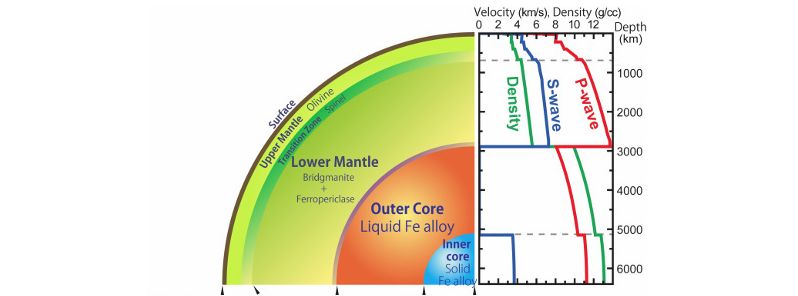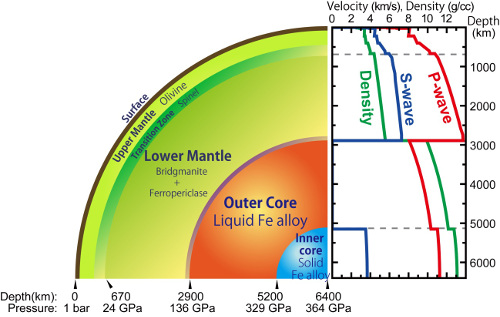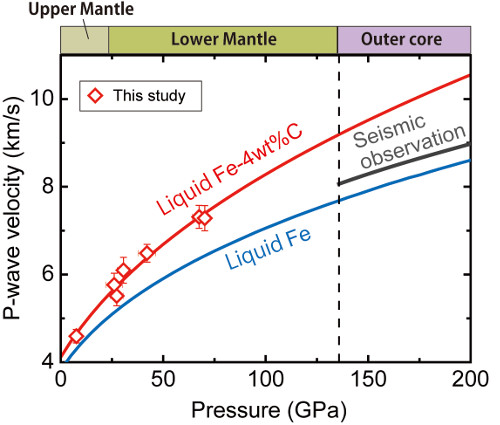First sound velocity in extreme conditions successfully estimated

New research, conducted in collaboration between the Materials Dynamics Laboratory at the RIKEN SPring-8 Center and the Tokyo Institute of Technology, has successfully measured the speed of sound in mixtures of liquid iron and carbon in extreme conditions, for the first time. This has allowed the scientists to extrapolate the values under the extreme conditions prevailing inside our planet, suggesting that at least 1.2% of Earth's core consists of carbon, RIKEN announced on November 24, 2015.
Propagation of seismic acoustic waves provides the most detailed information about the interior composition of our planet. Measurements of how these waves, such as those created by earthquakes travel through the Earth, have showed that 95% of our planet's core is composed of liquid material.
It has been known that the liquid in Earth's core is mostly comprised of molten iron and now researchers are doing their best to determine which elements are mixed with it, as the total density of the liquid is about 10% too small to contain only iron.

The interior of the Earth and sound velocity and density profiles. Image credit: RIKEN SPring-8 Center
“Understanding the composition of the liquid within the Earth's core is an important question, as it can give us clues about how the Earth was formed,” explained Alfred Baron, head of the Materials Dynamics Laboratory.
So far, experts have created a catalogue of sound velocities in different materials and temperature. However, materials inside the Earth are situated in extreme environmental conditions where temperatures reach up to several thousand degrees with pressure rising up to several hundred million hPa, making measurements extremely difficult.
Results of the newly conducted study have managed to fill up some gaps in the catalogue, by including the first liquid measurements taken in very extreme environment. To achieve that, scientist have used a combination of diamond anvil cell technology, laser heating and a large inelastic scattering spectrometer at SPring-8, over 20 tons in weight, to measure the sound velocity of liquid iron-carbon mixtures at very high temperatures and pressures.

P-wave velocity of liquid alloys. Image credit: RIKEN SPring-8 Center
The pressure in the outermost part of the liquid core reaches about 1.3 million atmospheres (1 atmosphere equals about 1 000 hPa) while temperatures reach about 3 727 °C (6 740 °F). The values of achieved pressure has been only about half that of the outermost part of the liquid core, however, geoscientists managed to extrapolate the values to core conditions.
“The extrapolation gives us important insights, suggesting that at most only about 1.2% of the core, by weight, is carbon. Thus while there may be, and, in fact, probably is, some carbon in the core, there must also be some other light elements, such as silicon, oxygen, sulfur or hydrogen," explained Yoichi Nakajima, first author of the study.
"While already leading the world in our ability to measure velocities like this under extreme conditions, we will continue to work with different materials and even more extreme conditions at a new RIKEN facility, the Quantum NanoDynamics Beamline, BL43LXU, at SPring-8," concluded Baron.
Reference:
- "Carbon-depleted outer core revealed by sound velocity measurements of liquid iron–carbon alloy" – Yoichi Nakajima, Saori Imada, Kei Hirose, Tetsuya Komabayashi, Haruka Ozawa, Shigehiko Tateno, Satoshi Tsutsui, Yasuhiro Kuwayama and Alfred Q. R. Baron – Nature Communications (2015) – doi:10.1038/NCOMMS9942
Featured image: The interior of the Earth and sound velocity and density profiles. Image credit: RIKEN SPring-8 Center

Commenting rules and guidelines
We value the thoughts and opinions of our readers and welcome healthy discussions on our website. In order to maintain a respectful and positive community, we ask that all commenters follow these rules:
We reserve the right to remove any comments that violate these rules. By commenting on our website, you agree to abide by these guidelines. Thank you for helping to create a positive and welcoming environment for all.